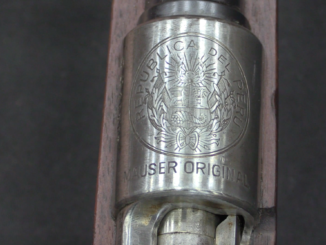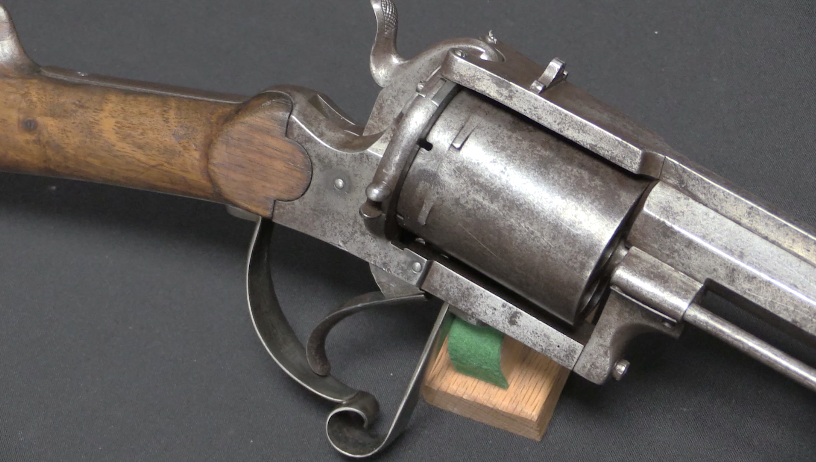The Argentine factory FMAP-DGFM was first set up to produce a copy of the Colt 1911, and in 1954 they began production of the PAM-1 (after demonstration of the first prototype in 1950). The PAM-1 was a copy of the American M3A1 “Grease Gun” chambered for 9x19mm Parabellum. Production ran until 1961, at which point the factory switched to production of the new FAL rifle for Argentine forces. By that time, about 33,000 had been produced.
Almost as soon as production ceased a process of conversion and upgrade began, creating the PAM-2. This involved adding a grip safety lever to the back of the magazine well. This prevented the gun from being cocked or fired, and it was most likely done to prevent cases of the guns firing when dropped. About half of the total production was converted to the new configuration, and a second small batch of about 1,100 PAM-2s were manufactured to this pattern in 1969. Most of the examples outside Argentina are PAM-2 conversions, as they were captured by British forces in the Falklands.
By the 1970s, the PM-3 had been officially replaced with the PAM-3, better known as the FMK submachine gun. The Grease Guns remained in service alongside the FMKs until the 1990s, however.
Many thanks to the Royal Armouries for allowing me to film and disassemble this rare submachine gun! The NFC collection there – perhaps the best military small arms collection in Western Europe – is available by appointment to researchers:
https://royalarmouries.org/research/national-firearms-centre/
You can browse the various Armouries collections online here:
https://royalarmouries.org/collection/




I wonder if the stock could be used as a cleaning rod?
Ian is either now banned for life from Argentina, or we will soon see him in Argentina reviewing British FALs, Sterlings, & BREN guns that were captured in the “Malvinas”.
“(…)demonstration of the first prototype in 1950(…)in 1954 they began production of the PAM-1(…)”
Earlier sub-machine gun model Halcón Model 1943 https://guns.fandom.com/wiki/Halc%C3%B3n_Model_1943 was made from 1943 to 1950. If it was ended due to full-filing needs production of new sub-machine gun might be considered low-priority project.
“(…)copy of the American(…)”
This direction is surprising considering relation of U.S.A w.r.t Argentine at that time (see BLUE BOOK ON ARGENTINA 1946) and Argentine stance towards German scientist and designers (see Kurt Tank)
“(…)grip safety lever to the back of the magazine well(…)”
Such device was earlier used in Brazilian INA MB-50 see 1st photo from top
http://modernfirearms.net/en/submachine-guns/brazil-submachine-guns/ina-mb-50-m-953-2/
Such safety is in Madsen smg also
First submachine gun to use this type of safety was the Italian TZ 45, and it was subsequently copied in various other designs.
I see Argentina did not copy the magazine loading tool built into the wire stock like on the US M3A1. I know hand loading the 45 ACP mags without the tool will give you gorilla thumbs.
“front line troops”
According to the official British narrative, the occupation force in the Falklands consisted largely of conscripts.
regular soldiers, who might have been more loyal to the Junta, or at least, less likely to join a revolution, remained at home.
I don’t know whether that narrative is true, or whether it is an enduring first casualty of the war to get Thatcher a second term in power
It is mostly true. Argentina kept mountain troops in the Andes due to concerns about neighbor Chile. The Royal Navy and the Armada de Chile have had fairly close relations since the time of Admiral Thomas Cochrane, 10th Earl of Dundonald.
Argentina deployed approx. 23k personnel: 10.6k in the navy [391 dead, 323 from the ARA_General Belgrano_ ex USS _Phoenix_, 10.3k army [191 KIA], 2.3k air force [55 KIA]. If we are to believe brigadier Basilio Lami Dozo of the air force, the Malvinas/ South Atlantic / Falkand Islands War as to be a prelude for an attack on Chile after the 1977-1979 Beagle Chanel saber rattling and crisis…